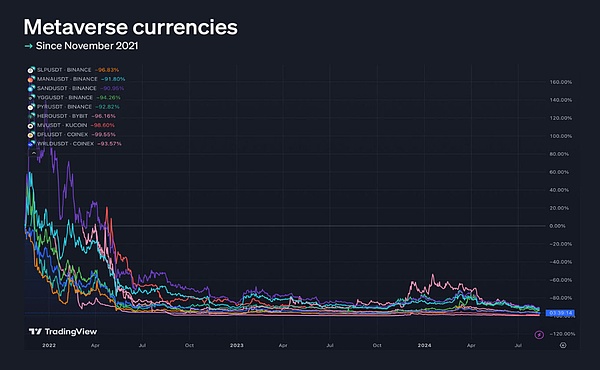Compiled by: MetaverseHub
In recent years, the technology community has shown great enthusiasm for the concept of "metaverse". The concept promises to transform the online experience, delivering immersive virtual worlds where we can work, play and socialize like never before.
Tech giants and investors have invested billions of dollars in this vision. Meta (formerly Facebook) is the leader among the 500 largest blockchains worth billions of dollars. However, recent data suggests that the Metaverse bubble may have burst, leaving many people skeptical about its future.
To understand the current situation, we need to step back and look at what the Metaverse promised in the first place.
Meta CEO Mark Zuckerberg has become the face of the movement, rebuilding his company , and invested heavily in virtual reality technology.
Citibank researchers even predicted that the Metaverse could attract 5 billion users and grow into a $13 trillion market.
These bold statements have sparked a gold rush as companies and individuals scramble to stake their claim on this digital frontier.

01.The rapid decline of the metaverse
Today, the situation is very different.
Meta’s ambitious metaverse division, RealityLabs, has been bleeding money.It lost $4.5 billion in the last quarter alone, bringing its total losses since its inception to $1.5 billion. These figures are a far cry from the profitable future once envisioned.
Even more telling is the fate of Horizon Worlds, Meta’s flagship adult-oriented metaverse. Despite significant marketing efforts, the platform struggled to attract its target audience. Ironically, it became unexpectedly popular with children, which was not its original purpose.
02.The Collapse of the Crypto Metaverse
The universe concept is not limited to traditional technology companies.
An entire ecosystem has emerged in Crypto-based virtual worlds that promise decentralized ownership and unique digital assets.
These platforms built on blockchain technology have been hyped up and their valuations have reached astronomical figures. However, they have also experienced a sharp decline.
Take The Sandbox as an example, The virtual world, which was once valued at more than $7 billion, has seen its daily trading volume plummet by 99.9%. At its peak, its trading volume reached $117 million, but now its average daily trading volume is only $8,000. US dollars.

This is not an isolated case. Another groundbreaking Crypto Metaverse platform, Decentraland, has seen a similar 99.9% drop in daily transaction volume, from $2.5 million at its peak to less than $5,000 today.
03 .The Decline of Digital Assets
The most striking thing about these virtual worlds is that digital assets can be owned and traded, usually using non-fungible tokens. These tokens can represent anything from virtual real estate to in-game items.
At the peak of the metaverse craze, the prices of these assets were eye-popping. Now, their value has almost evaporated.
In the Sandbox, NFT sales once reached $10.2 million in a single day, but now it is difficult to exceed $10,000.
This pattern is being repeated on other platforms, with AxieInfinity, once the poster child for “earn as you play” gaming, seeing its trading volume plummet from nearly $1 billion to less than $2 million.
The performance of cryptocurrencies associated with these “metaverse” projects has also been unsatisfactory. The value of tokens such as MANA (Decentraland), SAND (The Sandbox) and AXS (AxieInfinity) has dropped from 2021 to 2027. The November peak had plunged by more than 90%.

This recession is not just Due to the problems of individual projects, the entire Metaverse Crypto field has shrunk significantly, with its total market value falling from US$50 billion to US$16 billion.
04.What factors led to this collapse?
Several factors led to this rapid decline.
First, the initial hype created unrealistic The technology needed to deliver a truly immersive and seamless virtual experience is still in its infancy. Many users find current products clunky and disappointing compared to the promised vision.
Moreover, the concept itself may be too abstract to be adopted by the mainstream. Despite widespread adoption, it has been difficult for average internet users to understand how the Metaverse will meaningfully improve their digital lives. High entry costs, both in terms of hardware and learning curves, further limit its adoption. /p>
The broader economic recession and crypto market crash also played a major role. As investment capital became increasingly scarce and risk appetite decreased, many metaverse projects found themselves struggling to maintain development. and user growth.

Despite these setbacks, it is not too early to completely dismiss the Metaverse. It’s too early to make a concept.
Technology often goes through a cycle of hype, disillusionment, and eventual practical application. Some supporters, such as Mark Zuckerberg, believe in the long-term potential of the Metaverse and continue to invest in its development. Invest huge amounts of money.
History shows that even after a major market correction, innovative ideas will reappear in a more practical form.
As Amazon and eBay have shown, Just as companies like eBay emerged from the dot-com bubble to become tech giants, some metaverse projects may find their footing and realize value in ways we haven’t yet imagined.
 Dante
Dante







